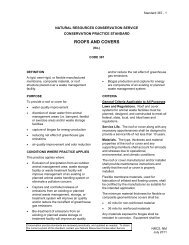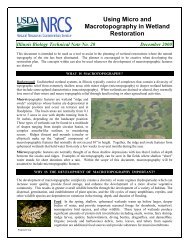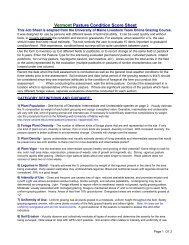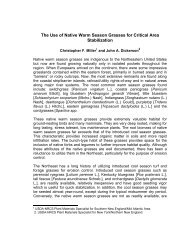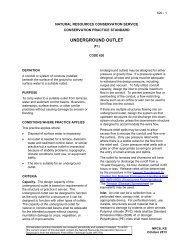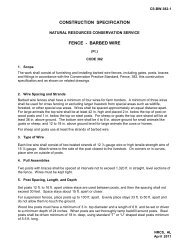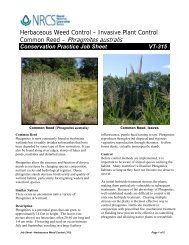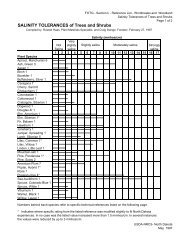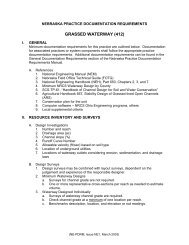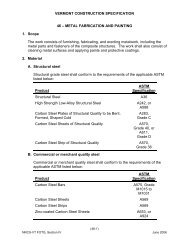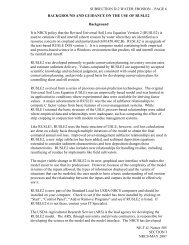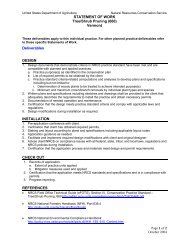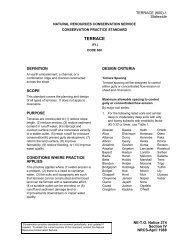Windbreak/Shelterbelt Establishment - Field Office Technical Guide ...
Windbreak/Shelterbelt Establishment - Field Office Technical Guide ...
Windbreak/Shelterbelt Establishment - Field Office Technical Guide ...
You also want an ePaper? Increase the reach of your titles
YUMPU automatically turns print PDFs into web optimized ePapers that Google loves.
380-1<br />
NATURAL RESOURCES CONSERVATION SERVICE<br />
CONSERVATION PRACTICE STANDARD<br />
WINDBREAK/SHELTERBELT ESTABLISHMENT<br />
(Feet)<br />
CODE 380<br />
DEFINITION<br />
<strong>Windbreak</strong>s or shelterbelts are single or multiple<br />
rows of trees or shrubs in linear configurations.<br />
PURPOSE<br />
Reduce soil erosion from wind.<br />
<br />
<br />
<br />
<br />
<br />
<br />
<br />
<br />
<br />
<br />
<br />
Protect plants from wind related damage.<br />
Alter the microenvironment for enhancing<br />
plant growth.<br />
Manage snow deposition.<br />
Provide shelter for structures, animals, and<br />
people.<br />
Enhance or create wildlife habitat.<br />
Provide noise screens.<br />
Provide visual screens.<br />
Improve air quality by reducing and<br />
intercepting air borne particulate matter,<br />
chemicals and odors.<br />
Delineate property and field boundaries.<br />
Improve irrigation efficiency.<br />
Increase carbon storage in biomass and soils.<br />
CONDITIONS WHERE PRACTICE APPLIES<br />
Apply this practice on any areas where linear<br />
plantings of woody plants are desired and suited<br />
for controlling wind, noise, and visual resources.<br />
Use other tree/shrub practices when wind, noise<br />
and visual problems are not concerns.<br />
CRITERIA<br />
General Criteria Applicable To All Purposes<br />
<br />
Species planted shall be suited for the<br />
planned practice purpose(s).<br />
<br />
<br />
<br />
<br />
<br />
<br />
<br />
<br />
Refer to NRCS Conservation Practice<br />
Standard Tree/Shrub <strong>Establishment</strong>, Code<br />
612, or to the specifications sheet for tree and<br />
shrub planting guidelines including age, size,<br />
handling, viability, storage and quality of the<br />
planting stock and permanent or temporary<br />
cover.<br />
Species planted must be adapted to the soils,<br />
climate and site conditions. The tool to use<br />
for this information is the Conservation<br />
Tree/Shrub Groups (CTSG) at the webpage<br />
above.<br />
Where possible choose native species over<br />
non-native species. If non-native species are<br />
used make sure the species chosen is not<br />
invasive or considered noxious. Refer to link<br />
below for a list of MN/MDA’s invasive and<br />
noxious plant species.<br />
All windbreaks will be oriented as close to<br />
perpendicular to the troublesome wind as<br />
possible regardless of season or direction.<br />
The location, layout and density of the<br />
planting will accomplish the purpose and<br />
function intended within a 20-year period.<br />
For the purposes of this standard, the term ‘H’<br />
shall mean height in feet of the tallest row of<br />
trees at 20 years after planting.<br />
The maximum design height (H) for the<br />
windbreak or shelterbelt shall be the expected<br />
height of the tallest row of trees or shrubs at<br />
age 20 for the given site. Refer to MN<br />
eFOTG, Section II at the webpage below for<br />
20-year tree and shrub heights.<br />
http://efotg.nrcs.usda.gov/references/public/<br />
MN/TreesShrubsCTSGsubgroups.xls<br />
Unless otherwise specified, the density of the<br />
windbreak shall be between 50 percent and<br />
NRCS-Minnesota<br />
August 21, 2009
380-2<br />
<br />
<br />
<br />
<br />
<br />
<br />
<br />
<br />
65 percent and contain a minimum of 1 row of<br />
a non-deciduous conifer. Figure 1 on page 6<br />
of the Specification Sheet shows designs for<br />
various densities.<br />
Where possible, choose native species of<br />
trees and shrubs over non-native species. If<br />
non-native species are chosen, make sure<br />
they are not invasive or considered noxious.<br />
Refer to the link below for a list of MN/MDA’s<br />
invasive and noxious plant species.<br />
http://www.mda.state.mn.us/plants/badplants/<br />
noxiouslist.htm<br />
The webpage below lists invasive terrestrial<br />
plants according to MN/DNR.<br />
http://www.dnr.state.mn.us/invasives/terrestri<br />
alplants/index.html<br />
Site preparation shall be sufficient for<br />
establishment and growth of selected<br />
species, not contribute to erosion and be<br />
appropriate for the site. Refer to NRCS<br />
Conservation Practice Standard Tree/Shrub<br />
Site Preparation, Code 490 for more<br />
information.<br />
Base spacing between individual plants on<br />
the needed growing space, plant type and<br />
species, accommodation of equipment and<br />
desired characteristics of the stem(s),<br />
branches and canopy as required for the<br />
specific purpose. Allow at least 4 feet extra<br />
width for equipment as necessary. Refer to<br />
spacing guides in the Specification Sheet<br />
attached to the end of the standard.<br />
Avoid planting trees or shrubs where they will<br />
interfere with structures and above or below<br />
ground utilities such as power lines, gas and<br />
water lines or septic lines.<br />
Follow local regulations regarding planting<br />
near property lines but trees and shrubs<br />
should be at least 20 feet from a property line.<br />
Where subsurface drains (tile lines) cross<br />
through a planting, sealed conduits will be<br />
installed a minimum of 100 feet from rows of<br />
large spreading trees and 75 feet from all<br />
other trees and shrubs.<br />
Avoid planting in areas of contaminated soil<br />
including areas affected by concentrated<br />
feedlot runoff; divert feedlot runoff away from<br />
the planting.<br />
<br />
<br />
<br />
<br />
<br />
<br />
Avoid creating blind corners at road<br />
intersections.<br />
When placing openings through a windbreak<br />
make openings on an angle to reduce the<br />
loss of wind protection. Whenever possible<br />
locate access roads at the ends of<br />
windbreaks beyond where snow drifts form.<br />
For all purposes, assess plantings for the<br />
potential to cause snow drifting onto public<br />
roadways.<br />
• Appropriate setback distances will be<br />
calculated for all plantings on the north and<br />
west sides of roadways.<br />
• Plantings on the south and east sides of<br />
roadways will be evaluated for back drifting<br />
of snow and creating shade patterns which<br />
slow snow and ice melting.<br />
• Avoid sites that will deposit snow on<br />
roadways unless additional plantings are<br />
placed upwind to mitigate snow drift<br />
problems.<br />
Protect the planting from adverse impacts<br />
such as livestock damage or fire. Use either<br />
the NRCS Conservation Practice Standard<br />
Fence, Code 382 or Access Control, Code<br />
472.<br />
If aesthetics is important, use a combination<br />
of needle leaf species and broadleaf species<br />
with features such as showy flowers,<br />
interesting forms and shapes, brilliant fall<br />
foliage, persistent colorful fruits or contrasting<br />
textures as appropriate.<br />
To create visual interest, use a mix of tall<br />
trees, small trees and shrubs. Use plant<br />
cultivars with desired characteristics. Use<br />
curvilinear designs and small group plantings<br />
adjacent to interior rows to increase visual<br />
sight diversity.<br />
Additional Criteria to Reduce Wind Erosion,<br />
and Protect and Enhance Plant Growth<br />
<br />
The interval between windbreaks shall be<br />
determined using current, approved wind<br />
erosion technology, such as the Wind Erosion<br />
Prediction System (WEPS) at:<br />
http://www.weru.ksu.edu/nrcs/wepsnrcs.html<br />
or other currently approved models. Interval<br />
widths shall not exceed that permitted by the<br />
soil loss tolerance (T) or other planned soil<br />
NRCS-Minnesota<br />
August 2009
380-3<br />
<br />
<br />
<br />
<br />
loss objectives. Calculations shall account for<br />
the effects of other practices in the<br />
conservation management system.<br />
The sheltered area is defined as ten times the<br />
design height (10H) on the leeward<br />
(downwind) side measured from the<br />
prevailing wind direction, and two times the<br />
design height (2H) on the windward (upwind)<br />
side of the windbreak. Growing plants are<br />
protected and wind erosion is controlled in the<br />
sheltered area provided by the windbreak.<br />
Base spacing on the level of plant protection<br />
needed. Common crops and their annual per<br />
acre tolerance to windblown soils are shown<br />
in Table 1 on page 10, along with density<br />
requirements, recommended number of rows<br />
and plant types.<br />
For wind erosion control, the minimum barrier<br />
density is 40 percent and the maximum is 60<br />
percent. This can be achieved through use of<br />
properly spaced plants within a single row<br />
windbreak comprised of species from Table 2.<br />
Table 3 gives spacing recommendations for<br />
commonly used windbreak species.<br />
For the wind erosion control system,<br />
temporary measures will be installed as<br />
needed such as residue and tillage<br />
management, conservation crop rotation,<br />
conservation cover, or other practices as<br />
appropriate, to supplement the windbreak<br />
until it is fully functional.<br />
Additional Criteria to Manage Snow<br />
<br />
<br />
<strong>Windbreak</strong>s for snow management will be<br />
located so that snow deposition will not pose<br />
a health or safety problem, management<br />
constraints or obstruct human or livestock<br />
travel paths.<br />
Where water erosion and/or runoff from<br />
melting snow are a hazard, control these<br />
erosive forces by supporting practices such<br />
as NRCS Conservation Practices Diversion,<br />
Code 362; Grassed Waterways, Code 412; or<br />
Structures for Water Control, Code 587 or<br />
other appropriate practices.<br />
Blowing Snow Management<br />
The windbreak (living snow fence) will be<br />
oriented as close to perpendicular to the<br />
snow-bearing wind as possible so that the<br />
protected area is on the leeward side. To find<br />
<br />
<br />
<br />
<br />
the general direction of snow transport, use<br />
the Analysis of Snow Climatology Program<br />
webpage at:<br />
http://climate.umn.edu/snow_fence/Compone<br />
nts/Design/introduction.htm<br />
and click on Wind Analysis from the menu at<br />
the left.<br />
The minimum barrier density is 50 percent for<br />
snow accumulation on roads, highways and<br />
ditches, during expected snow-producing<br />
months. The barrier density and appropriate<br />
minimum set-back distance will be<br />
determined on a site-specific basis using the<br />
design criteria found in the Living Snow<br />
Fence Program on MnDOT’s webpage at: .<br />
http://climate.umn.edu/snow_fence/Compone<br />
nts/Design/introduction.htm and click on<br />
“Begin Design Module”. Follow the steps.<br />
An optional design element that increases the<br />
effectiveness for this purpose includes a<br />
dense trip-row of shrubs planted 40 to 100<br />
feet windward of the windbreak. In this<br />
option, the design requires plant-to-plant<br />
spacing (within row) at 3 to 10 feet<br />
(depending on 20-year heights); or a twin-row<br />
high-density design of shrubs planted 3 to 10<br />
feet within row (depending on 20-year<br />
heights) and 8 to 16 feet row-to-row spacing.<br />
Stagger the placement so no 2 shrubs are<br />
planted directly across from each other. The<br />
resulting snow catch area will prevent blowing<br />
and drifting snow onto the living snow fence.<br />
Multiple row plantings for snow accumulation<br />
will be designed so that snow deposition will<br />
not adversely impact plants located in<br />
downwind (leeward) rows. Tree and shrub<br />
species most suitable for leeward rows<br />
include dogwoods, viburnums, lilacs, and<br />
honeysuckles; followed by junipers, pines,<br />
spruces, red cedar, service berries,<br />
hazelnuts, ninebark, sumacs, oaks and<br />
maples (see exceptions below).<br />
Shrubs and trees susceptible to snow load<br />
damage (should be avoided in leeward rows)<br />
include: plums, chokecherry, nannyberry, pin<br />
cherry, buffaloberry, alders, arborvitae<br />
(Northern white-cedar), birches, elms,<br />
poplars, willows, soft maples such as silver<br />
maple and cultivated or varietal maples.<br />
NRCS-Minnesota<br />
August 2009
380-4<br />
Snow Distribution Management<br />
<br />
<br />
For snow distribution across a field, to<br />
increase infiltration during snow melt, the<br />
minimum windbreak density is 25 percent and<br />
the maximum density is 50 percent. Densities<br />
are measured during expected snowproducing<br />
months. The interval between<br />
barriers will not exceed 20H and will depend<br />
on the 20-year heights of the plants. Use the<br />
Conservation Tree and Shrub Groups (CTSG)<br />
to find 20-year plant heights.<br />
Pruning, renovation and planting are cultural<br />
activities used to manage windbreak density<br />
for snow distribution purposes.<br />
Additional Criteria to Provide Shelter for<br />
Structures, Livestock, and People<br />
<br />
<br />
<br />
The planting will be oriented as close to<br />
perpendicular as possible to the troublesome<br />
winds.<br />
For wind and snow protection, the minimum<br />
barrier density will be 65 percent, the<br />
minimum 20-year height is 20 feet and the<br />
area to be protected will fall within 10H (200<br />
ft). The minimum barrier density can be<br />
achieved with:<br />
• a minimum of 3 rows of non-deciduous<br />
conifers or<br />
• 2 rows of non-deciduous conifers and a<br />
dense shrub row.<br />
Non-deciduous conifers include pines,<br />
spruces, firs, junipers, cedars, yews and<br />
hemlocks. Deciduous conifers are larches<br />
and tamaracks.<br />
Appropriate hardwoods and deciduous conifer<br />
species can be substituted for non-deciduous<br />
conifers at a ratio of 2 rows to 1. All plantings<br />
using this design will contain at least one row<br />
of non-deciduous conifer species and a dense<br />
shrub row.<br />
Particularly suitable species of shrubs<br />
include: Cornus (dogwood), Corylus (hazels),<br />
Crataegus (cragbapple), Prunus (cherries,<br />
pears and plums) and Salix (willows). Other<br />
species of shrubs may also be suitable.<br />
If sufficient space is available, recommend a<br />
dense single or twin row of shrubs, planted 40<br />
to 100 feet windward of the windbreak, to<br />
create a snow trip and snow catch area. The<br />
<br />
purpose of the snow trip will: Refer to Figure<br />
2, page 7 in the Specifications Sheet for a<br />
design of a trip-row and a twin-row windbreak.<br />
a) reduce snow deposition and potential<br />
snow damage of plants within the<br />
windbreak;<br />
b) allow placement of the windbreak<br />
closer to the area being protected<br />
and;<br />
c) reduce the minimum number of rows<br />
in the windbreak by one.<br />
Drainage of snowmelt from drifts associated<br />
with the windbreak shall not flow across a<br />
livestock area and livestock waste shall not<br />
flow into the windbreak. Add appropriate<br />
waste control practices as necessary.<br />
Set-back Distance for Structures<br />
The set-back distance from farmstead<br />
buildings, all structures or feedlots to the<br />
outside row (most windward) of the windbreak<br />
will be determined by the Annual Wind<br />
Erosion Climatic Factor ("C" Factor) assigned<br />
to each county.<br />
• The minimum setback distance for counties<br />
having a "C" Factor greater than 15 will be<br />
175 feet.<br />
<br />
• The minimum setback distance for counties<br />
having a "C" Factor less than 10 will be 100<br />
feet.<br />
Setback<br />
distance<br />
A setback distance of 175 feet is desirable in<br />
all locations to avoid snow accumulation and<br />
avoid turbulence. A minimum set-back of 100<br />
feet is used where property lines or other<br />
features will not allow the 175 foot set-back or<br />
where winds will be significantly reduced by<br />
existing topography or large blocks of existing<br />
forest cover.<br />
NRCS-Minnesota<br />
August 2009
380-5<br />
Additional Criteria to Enhance or Create<br />
Wildlife Habitat<br />
<br />
<br />
<br />
<br />
<br />
<br />
<br />
A minimum of 10 rows is required for<br />
establishing or creating wildlife habitat with<br />
windbreaks. Refer to NRCS Conservation<br />
Practice Standard Upland Wildlife Habitat<br />
Management, Code 645 for more specific<br />
information about windbreaks for wildlife<br />
habitat development.<br />
Design dimensions of the planting shall be<br />
adequate for targeted wildlife species.<br />
Multiple-row shrub windbreaks may be<br />
enhance for wildlife by spacing plants within<br />
rows as wide apart as guidelines allow to<br />
enhance fruit and seed production.<br />
In multiple-row plantings containing more than<br />
3 rows, the leeward (downwind) rows shall be<br />
planted in groups of segments containing 5 or<br />
more plants of one species in a series to<br />
enhance wildlife values.<br />
Shrub rows should be located on the outside<br />
rows (most windward rows) of the windbreak<br />
to create a diverse edge zone for an<br />
enhanced woodland edge zone or lane. Use<br />
a curvilinear planting design rather than<br />
straight rows when planting for wildlife habitat<br />
enhancement.<br />
Between the windbreak rows (depending on<br />
competition with primary windbreak species)<br />
plant grasses, herbs and/or forbs that provide<br />
food and shelter for the targeted wildlife<br />
species.<br />
Use plants of different sizes, growth forms<br />
and food bearing capabilities and densities to<br />
increase plant diversity.<br />
Additional Criteria for Screens<br />
Noise Screens<br />
<br />
Noise screens shall be at least 65 percent<br />
dense and as close to the noise source as<br />
possible.<br />
The minimum design for noise screens is 2<br />
rows of woody plants, one row of shrubs<br />
closest to the noise source and one row of tall<br />
trees toward the protected area.<br />
<br />
Use the tallest trees practical in the design.<br />
However the species recommended must be<br />
at least as tall as the noise source.<br />
<br />
<br />
<br />
<br />
<br />
For high-speed traffic noise, the screen shall<br />
not be less than 65 feet wide where possible.<br />
For moderate-speed traffic noise, the barrier<br />
width shall not be less than 20 feet wide.<br />
If needed, select species that are tolerant to<br />
noxious emissions, sand, gravel depositions<br />
or salt spray from traffic areas. Some suitable<br />
plants include: arborvitae (Northern whitecedar),<br />
hawthorns, American basswood or<br />
linden, sugar or red maples, spruces,<br />
viburnums, and firs.<br />
For non-traffic noise screens, the length of the<br />
noise screen should be twice as long as the<br />
distance from the noise source to the<br />
receiver.<br />
Plant trees/shrubs using the minimum width<br />
between plants. See spacing guidelines<br />
under Plans and Specifications on Page 2.<br />
When possible use plants with dense foliage<br />
and persistent branches from the ground up.<br />
A few recommended plants are nondeciduous<br />
conifers such as: Austrian pine,<br />
blue spruce, eastern redcedar, eastern white<br />
pine, arborvitae (Northern white-cedar),<br />
ponderosa pine, Norway (red) pine, Scotch<br />
(Scots) pine, Norway spruce and white<br />
spruce. Deciduous woody plants include:<br />
Peking cotoneaster, common and Late<br />
(Legacy) lilac. Any non-deciduous conifer,<br />
suitable for the site conditions, is<br />
recommended for year-around noise screens.<br />
The species listed here are particularly<br />
effective as noise screens. Deciduous woody<br />
plants provide less noise reduction benefits<br />
during leaf-off conditions. Many other<br />
deciduous trees or shrubs, suitable for the<br />
site conditions, can be recommended for<br />
seasonal noise screens.<br />
Visual Screens<br />
Visual screens shall be located as close to<br />
the observer as possible and have at least 1<br />
row of sufficient density to provide an<br />
adequate visual screen. For year around<br />
screening, non-deciduous conifers such as<br />
pines, firs and spruces will be used.<br />
<br />
The woody plants will be of sufficient height to<br />
fully screen the offending view. The screen<br />
will be of sufficient width to cover the<br />
offending view.<br />
NRCS-Minnesota<br />
August 2009
380-6<br />
<br />
<br />
<br />
Appropriate landscape design elements will<br />
be used to construct the screen. Such design<br />
elements shall consider at least one of the<br />
following:<br />
• color, texture and plant diversity;<br />
• a mixture of large trees, small trees and<br />
various sized shrubs;<br />
• curvilinear designs and/or small group<br />
plantings adjacent to interior rows to<br />
increase visual sight diversity;<br />
• combinations of evergreen species and<br />
hardwood species (or cultivars) with<br />
features such as showy flowers, brilliant fall<br />
foliage, persistent colorful fruits or<br />
noteworthy growth forms and shapes to<br />
enhance interest.<br />
Use visual screens to reduce neighbor’s<br />
views of animal production and waste<br />
facilities, which may lead to reduced odor<br />
complaints associated with visual stimulus of<br />
olfactory senses.<br />
Use MnDOT’s Plant Selector at<br />
http://dotapp7.dot.state.mn.us/plant/<br />
to obtain suggested plants for specific design<br />
criteria such as: form, color, texture and other<br />
important characteristics in visual screens.<br />
Improve Air Quality by Reducing and<br />
Intercepting Air Borne Particulate Matter,<br />
Chemicals and Odors<br />
The windbreak shall have no less than 2-<br />
rows; one row consisting of a tall tree species<br />
and the second row a dense shrub species. If<br />
year-around function is needed, the tall tree<br />
species must be a non-deciduous conifer.<br />
<br />
Select and maintain tree and shrub species<br />
with foliar and structural characteristics to<br />
optimize interception, adsorption and<br />
absorption of airborne chemicals or odors.<br />
Optimal foliar characteristics include fleshy<br />
leaves, dense branches, and leaves with<br />
waxy coatings and non-deciduous leaves<br />
(leaves remain year-around). Some tree and<br />
shrub species suitable for this purpose<br />
include: Thuja occidentalis (American<br />
arborvitae or northern white-cedar), Pinus<br />
resinosa (red pine), Picea spp. (spruces),<br />
Abies balsamea (balsam fir), Sorbus<br />
americana (American mountain ash), Cornus<br />
<br />
<br />
<br />
<br />
sericea (redosier dogwood), Crataegus spp.<br />
(Hawthorns), Acer rubrum (red maple), Acer<br />
saccharum (sugar maple), Juglans nigra<br />
(black walnut), Tilia americana (American<br />
basswood or linden), Viburnum spp.<br />
(viburnums) and Quercus rubra (Northern red<br />
oak).<br />
Adjust windbreak densities to meet air<br />
movement needs for naturally ventilated<br />
livestock confinement systems.<br />
If possible, select species based on high leaf<br />
surface roughness (plants with leaf hairs, leaf<br />
veins, and/or smaller leaf size), complex leaf<br />
shapes, large leaf circumference to area<br />
ratios and medium to rapid growth rates and<br />
branches with lots of leaves. Examples<br />
include leaves of conifers such as spruces,<br />
firs, pines, yews and larches and leaves of<br />
hardwoods such as maples, lindens, some<br />
oaks and hawthorns.<br />
Keep the inner row of windbreak plantings<br />
from all buildings and waste storage areas at<br />
least 10 times the exhaust fan diameter or 50<br />
feet, whichever is farther.<br />
Use the widest possible between-row<br />
spacings to increase particle surface area<br />
contact and foliage light levels.<br />
Air Borne Particulate Matter<br />
Odors<br />
• If a series of windbreaks are needed; the<br />
windbreak interval shall be less than or<br />
equal to10H depending on site conditions<br />
and related supporting conservation<br />
practices.<br />
• <strong>Windbreak</strong> density on the upwind<br />
(windward) side shall be between 50<br />
percent and 65 percent to reduce the air<br />
flow into the source area.<br />
• <strong>Windbreak</strong> density on the leeward side<br />
shall be greater than 65 percent (NTE 80<br />
percent) to intercept particulates.<br />
• Vegetation shall be maintained to control<br />
odor movement and chemical drift.<br />
Orientation of the shelterbelt shall be<br />
perpendicular to the predominant wind<br />
direction and between the source area and<br />
the area sensitive to the source.<br />
NRCS-Minnesota<br />
August 2009
380-7<br />
• Locate shelterbelts upwind (windward) of<br />
the odor producing area to disrupt air flow<br />
around the odor producing area, increase<br />
turbulence in the boundary layer over the<br />
area and increase dilution of contaminants<br />
in the air, thus reducing odor.<br />
Chemicals<br />
• Locate shelterbelts upwind (windward) of<br />
the chemical application area to reduce air<br />
movement and subsequent chemical drift.<br />
• Locate shelterbelts downwind (leeward) of<br />
the chemically treated fields to intercept<br />
fumes, drift and/or chemically treated soil.<br />
Species selections should be compatible<br />
with pesticides to be used. Maintain a 60<br />
percent or greater density to insure<br />
adequate interception of drifting particles.<br />
Additional Criteria for Improving Irrigation<br />
Efficiency<br />
<br />
<br />
<br />
Use a minimum of one-row (conifers.<br />
hardwoods or shrubs) to reduce wind effects<br />
on sprinkler sprays and slow evaporation from<br />
the crop field.<br />
For sprinkler irrigation systems, the perimeter<br />
windbreak shall be at least as tall as the<br />
sprinkler heads (irrigation water spray).<br />
<strong>Windbreak</strong>s shall not interfere with the<br />
operation of the irrigation system. Leave<br />
openings for wheel tracks if using windbreaks<br />
under a center pivot system. Recommend<br />
plants that will fit under the irrigation<br />
equipment at maturity.<br />
Additional Criteria for Increasing Carbon<br />
Storage in Biomass and Soils<br />
<br />
<br />
<br />
Select plants that are adapted to the site and<br />
have high rates of carbon sequestration.<br />
Plant at the full stocking rate for the site. In<br />
MN the rate of carbon sequestration is<br />
highest with red and white pine forests, then<br />
spruce-fir followed by oak-hickory.<br />
Maximize the width (# of rows) and length of<br />
the windbreak to fit the site.<br />
When using trees and shrubs for greenhouse<br />
gas reduction, prediction of carbon<br />
sequestration rates shall be made using<br />
current approved carbon sequestration<br />
modeling technology.<br />
<br />
Maintain optimal water and nutrient needs for<br />
the planting.<br />
CONSIDERATIONS<br />
Use plant material guides to choose tree and<br />
shrub species including Conservation Tree<br />
and Shrub Groups (CTSG), MnDOT’s Plant<br />
Selector, NRCS’s PLANTS Database and/or<br />
the Vegespec Model as appropriate for the<br />
purpose, function and design of the practice.<br />
These references are available in the EFOTG<br />
under Section I, B Plant Selection Tools.<br />
<br />
<br />
<br />
<br />
<br />
<br />
<br />
<br />
Older age and medium to larger size planting<br />
stock, including bare rooted, transplants,<br />
balled and burlap and container grown stock,<br />
are recommended in single row and minimum<br />
design windbreaks. Death loss is more<br />
critical in these designs and larger and older<br />
planting stock may provide an advantage in<br />
survival rates.<br />
Favor the use of seedlings certified through<br />
the Minnesota Crop Improvement Association<br />
(MCIA). Refer to Plant Materials <strong>Technical</strong><br />
Note #4 for information on certified seedlings.<br />
When available and appropriate recommend<br />
planting stock with known superior traits and<br />
named varieties, such as those released<br />
through the Plant Materials Program.<br />
Selection of plants for use in windbreaks<br />
should favor species or varieties tolerant to<br />
anticipated herbicide use.<br />
Moisture conservation or supplemental<br />
watering may be needed for plant<br />
establishment and growth during the<br />
establishment period when moisture<br />
conditions are too low for plant establishment.<br />
Where pesticide spray drift from adjacent<br />
cropland could adversely effect windbreak<br />
plants consider establishing a 10 foot-wide tall<br />
grass barrier adjacent to and immediately<br />
upwind of the windbreak.<br />
Avoid plants which may be alternate hosts to<br />
undesirable pests for example planting<br />
currents (Ribes spp.) near white pines could<br />
lead to an outbreak of white pine blister rust.<br />
Refer to Biology <strong>Technical</strong> Note #4 "Wildlife<br />
Habitat Evaluation System" for wildlife habitat<br />
assessment guides for shelterbelts, and field<br />
windbreaks.<br />
NRCS-Minnesota<br />
August 2009
380-8<br />
<br />
<br />
<br />
<br />
<br />
<br />
<br />
<br />
<br />
All windbreak designs should complement<br />
natural features. A good tool to use for<br />
visualizing designs is the CanVis Visual<br />
Simulation Kit, free CCE approved software<br />
which can be found at:<br />
http://www.unl.edu/nac/simulation/<br />
If appropriate, encourage the use of native<br />
species. Do not favor native species if they<br />
are not capable of providing the designed<br />
windbreak function. Refer to Standard 645,<br />
Wildlife Upland Habitat Management for<br />
information on native trees and shrubs.<br />
Limit recommending trees and shrubs that<br />
have the potential to spread and reproduce<br />
off-site.<br />
Plants established within cropping systems<br />
that have root systems which adversely effect<br />
crop growth can be root pruned, refer the<br />
standard 650, <strong>Windbreak</strong>/<strong>Shelterbelt</strong><br />
Renovation.<br />
Where early wind and snow protection is<br />
desired, use close spacing guidelines within<br />
the rows, however, thinning or pruning of<br />
these close growing trees may be required to<br />
maintain the optimal function of the<br />
windbreak; refer to NRCS Conservation<br />
Practice Standard <strong>Windbreak</strong>/<strong>Shelterbelt</strong><br />
Renovation, Code 650.<br />
If odor control is the primary purpose, design<br />
and layout should take into account future<br />
expansion facility needs and the placement of<br />
natural or artificial barriers near exhaust fans<br />
on tunnel-ventilated livestock buildings.<br />
<strong>Windbreak</strong>s for odor and chemical control<br />
increase in effectiveness as the amount of<br />
foliage available for intercept increases.<br />
Multiple row, wide plantings offer greater<br />
interception potential than do smaller, close<br />
planted designs.<br />
Screens for noise control can be more<br />
effective when combined with properly sited<br />
earth mounds and/or solid board fences.<br />
Adding additional tree rows periodically<br />
establishes a diversity of age classes and<br />
extends the long-term effectiveness of the<br />
windbreak/shelterbelt. When designing the<br />
windbreak take into account future<br />
renovations.<br />
<br />
<br />
Increasing carbon storage can be<br />
accomplished by eliminating tillage and<br />
planting native grasses once the windbreak is<br />
established.<br />
Including a maintenance area around<br />
windbreaks allows for easier access for<br />
equipment and for activities such as pruning,<br />
thinning and weed control.<br />
PLANS AND SPECIFICATIONS<br />
Specifications for this practice shall be<br />
prepared for each site and recorded using the<br />
approved job sheet and narrative statements<br />
in the conservation plan or other acceptable<br />
documentation.<br />
<br />
<br />
Documentation shall specify the requirements<br />
for installing the practice, such as the kind,<br />
amount or quality of materials to be used, or<br />
the timing or sequence of installation<br />
activities. Requirements for operation and<br />
maintenance of the practice shall be<br />
incorporated into the site specific job sheet.<br />
Required supporting data includes mandatory<br />
documentation, as above, practice<br />
objective(s), soils information, conservation<br />
tree and shrub group, maintenance and<br />
erosion control, thinning or pruning<br />
requirements, tree/shrub planting plan (MN-<br />
CONS-7 or other suitable document).<br />
OPERATION AND MAINTENANCE<br />
Perform the following actions to insure that<br />
this practice functions as intended throughout<br />
its expected life. These actions include<br />
normal repetitive activities in the application<br />
and use of the practice (operation) and repair<br />
and upkeep of the practice (maintenance):<br />
<br />
<br />
<br />
Inspect the windbreak periodically to ensure<br />
protection and restoration from adverse<br />
impacts. Examples of adverse impacts<br />
include excessive equipment traffic, pest<br />
infestations, drift from pesticide use on<br />
adjacent lands, storm damage and fire.<br />
Livestock shall be controlled or excluded as<br />
necessary to achieve and maintain the<br />
intended purpose.<br />
Damaging pests will be monitored and<br />
controlled. Repellents, poisons, tubing,<br />
netting, fencing and cages of various kinds<br />
NRCS-Minnesota<br />
August 2009
380-9<br />
<br />
<br />
<br />
<br />
<br />
<br />
may be needed to control rodents and animal<br />
damage.<br />
Replacement of dead trees or shrubs will be<br />
required until the windbreak is fully functional<br />
and at no time should two adjacent plants be<br />
missing throughout the life of the windbreak<br />
Control vegetative competition until the<br />
practice is fully established and functional.<br />
If using chemicals to control insects or<br />
diseases, follow the guidelines in NRCS<br />
Conservation Practice Standard Pest<br />
Management, Code 595.<br />
Periodic applications of nutrients and/or<br />
irrigation may be needed to maintain plant<br />
vigor.<br />
As applicable, control of wind or concentrated<br />
flow erosion shall be continued in the area upwind<br />
or up-gradient of the windbreak to<br />
maintain its function. Following severe<br />
storms check for evidence of sediment<br />
deposit, erosion or concentrated flow<br />
channels and take corrective action as<br />
necessary.<br />
Maintain central stem on trees by eliminating<br />
forks and multiple leaders. The trees or<br />
shrubs will be thinned or pruned to maintain<br />
optimal health and function. Use NRCS<br />
Conservation Practice Standards<br />
<strong>Windbreak</strong>/<strong>Shelterbelt</strong> Renovation, Code 650<br />
or Tree/Shrub Pruning Code 660 for these<br />
maintenance activities.<br />
RESOURCES<br />
American Nursery and Landscape<br />
Association. 2004. American Standard for<br />
Nursery Stock, Washington DC.<br />
http://www.anla.org/<br />
Brandle, J. and Nickerson, H., 1997<br />
<strong>Windbreak</strong>s for Snow Management.<br />
University of NE, Lincoln, NE.<br />
<br />
<br />
Burns, Russell M., and Barbara H. Honkala,<br />
tech cords. 1990 Silvics of North America. 1.<br />
Conifers; 2. Hardwoods. Agriculture<br />
Handbook 654. U.S. Department of<br />
Agriculture, Forest Service. Washington, DC.<br />
http://www.na.fs.fed.us/spfo/pubs/silvics_man<br />
ual/table_of_contents.htm<br />
Minnesota Inter-agency Living Snowfence<br />
Task Force, 1999. Catching the Snow with<br />
<br />
<br />
<br />
<br />
<br />
<br />
<br />
<br />
Living Snowfences. University of MN, MI-<br />
7311-S, St. Paul, MN.<br />
Minnesota Association of Soil and Water<br />
Conservation Districts Forestry Committee.<br />
Minnesota Tree Handbook. McGregor<br />
Printing and Graphics. Tamarack, MN.<br />
Minnesota Department of Transportation.<br />
Living Snow Fences: Control of Blowing and<br />
Drifting Snow webpage.<br />
http://www.dot.state.mn.us/environment/living<br />
snowfence/<br />
Scholten, H.S., 1989. <strong>Field</strong> <strong>Windbreak</strong>s.<br />
University of MN, NR-FO-0824, St. Paul, MN.<br />
Scholten, H.S., 1988. Farmstead <strong>Shelterbelt</strong>s<br />
- Protection Against Wind and Snow.<br />
University of MN, BU-0468, St. Paul, MN.<br />
USDA, NRCS National Agroforestry Center,<br />
Idaho Resource Conservation and<br />
Development Association. 1999. Living Snow<br />
Fences. Boise, Idaho.<br />
http://www.unl.edu/nac/morepublications/livin<br />
gsnowfences.pdf<br />
USDA, NRCS National Agroforestry Center.<br />
<strong>Windbreak</strong> Series. USDA, NRCS, University<br />
of Nebraska-Lincoln Extension and North<br />
Dakota State University.<br />
• How <strong>Windbreak</strong>s Work<br />
• <strong>Windbreak</strong> <strong>Establishment</strong><br />
• <strong>Windbreak</strong>s for Livestock Operations<br />
• <strong>Windbreak</strong>s for Rural Living<br />
• <strong>Windbreak</strong> Management<br />
• <strong>Windbreak</strong>s for Snow Management<br />
• <strong>Windbreak</strong>s and Wildlife<br />
• <strong>Windbreak</strong>s in Sustainable Agricultural<br />
Systems<br />
• <strong>Windbreak</strong> Renovation<br />
• <strong>Field</strong> <strong>Windbreak</strong>s<br />
• <strong>Windbreak</strong>s for Fruit and Vegetable Crops<br />
http://www.unl.edu/nac/morepublications.htm<br />
USDA, NRCS National Agroforestry Center.<br />
2008. Conservation Buffers: Design<br />
<strong>Guide</strong>lines for Buffers, Corridors, and<br />
Greenways. General <strong>Technical</strong> Report SRS-<br />
109.<br />
http://www.unl.edu/nac/bufferguidelines/docs/<br />
conservation_buffers.pdf<br />
USDA, NRCS <strong>Windbreak</strong>s for Conservation,<br />
1997. Agriculture Information Bulletin 339.<br />
NRCS-Minnesota<br />
August 2009
380-10<br />
Table 1 - Crop Sensitivity to Blowing Soil and <strong>Windbreak</strong> Recommendations<br />
The windbreak should be at least as tall as the crop being protected. Compatible conservation practices, such as<br />
cover crops, conservation cover, or other appropriate practices should be used until the windbreak has reached a<br />
fully functioning height.<br />
If using permanent compatible soil control practices, the windbreak density can be reduced to 40 percent while<br />
maintaining adequate crop protection and avoiding snow drift problems that can result with windbreak densities<br />
equaling 60 percent or more.<br />
Non-deciduous conifers include: pines, spruces, firs, junipers, cedars, hemlocks and yews. Not included are<br />
larches and tamaracks.<br />
Tolerance to<br />
blowing soil<br />
(# tons soil/ac.)<br />
Tolerant<br />
(3 tons)<br />
Moderately<br />
tolerant<br />
(2 tons)<br />
Low tolerance<br />
(1 ton)<br />
Intolerant<br />
(< 1 ton)<br />
Crop<br />
barley, buckwheat, oats, rye,<br />
wheat, flax, millet*<br />
corn, grain sorghum,<br />
sunflowers<br />
apples, asparagus, broccoli,<br />
cabbage, cherries, egg<br />
plant, grapes, peaches,<br />
pears, peppers, soybeans,<br />
sweet corn, sweet potatoes<br />
alfalfa, beans, cotton,<br />
cucumbers, cabbage, green<br />
peas, lettuce, onions,<br />
potatoes, spinach, soy<br />
beans, squash, sugar beets,<br />
Recommended number of rows and type of woody<br />
plants needed to achieve 40 - 60% density to reduce<br />
damage from blowing soil<br />
Option 1: If protection is needed more during the growing<br />
season rather than at planting, a single row of<br />
hardwoods with a 12-foot plant-to-plant spacing will<br />
provide adequate protection. Option 2: A single conifer<br />
row could also be used with a plant-to-plant spacing of<br />
10 -16 feet.<br />
Option 3: A double row of shrubs planted 3 to 10 feet<br />
within-row and 6 - 12 feet between row spacing would<br />
provide adequate protection.<br />
Option 4: If protection is needed at planting, follow the<br />
options for low tolerance.<br />
See recommendations for tolerant above. Use the<br />
closest spacings for within-row and between-row<br />
spacings.<br />
Option 1: A single row of densely spaced non-deciduous<br />
conifers. Use a plant-to-plant spacing of 8 – 10 feet.<br />
Option 2: Use 2 or more rows with a plant-to-plant<br />
spacing from 10 - 16 feet; and row-to-row spacing of 10 -<br />
20 feet.<br />
Option 3: A dense shrub row can replace a nondeciduous<br />
conifer row if using 2 or more rows in the<br />
windbreak.<br />
Option 4: Use 2-rows of dense shrubs that are at least as<br />
tall as the crop. Use a plant-to-plant spacing of 3 to 10<br />
feet and a row-to-row spacing of 10 to 12 feet depending<br />
on the 20-year height of the species.<br />
See recommendations for low tolerance employing the<br />
closest within-row and between-row spacings.<br />
tomatoes<br />
*The economic benefits attributed to windbreaks tend to decrease with grain crops if the windbreaks remove<br />
greater than 5 percent of the cropland area.<br />
NRCS-Minnesota<br />
August 2009
380-11<br />
Table 2 - Recommended Species for Use in Single-row <strong>Windbreak</strong>s<br />
The following species are suitable for use in single row windbreaks*. See Section II of the eFOTG for<br />
additional information on which species are suited to the soils at the site on the webpage below:<br />
http://efotg.nrcs.usda.gov/references/public/MN/TreesShrubsCTSGsubgroups.xls<br />
Black Hills spruce 1/ Hickories 1/ Robusta poplar 2/<br />
Bur oak Jack pine 1/ Scotch pine<br />
Carolina (Norway) poplar 2/ Kentucky coffeetree 1/ Siberian larch 1/ 3/<br />
Crabapples 1/ Lilacs (Chinese, common or purple) Siouxland cottonwood<br />
Eastern redcedar 1/ Northwest poplar Silver maple 1/<br />
Eastern white pine 1/ Norway spruce 1/ White spruce<br />
Hackberry 1/ 3/ Ponderosa pine 1/ Willows 3/<br />
Hawthorns 1/ Red pine 1/<br />
*Ashes (true ash species are in the genus “Fraxinus”) are no longer considered suitable for single-row windbreaks<br />
due to the possible threat of the emerald ash borer.<br />
1/ Rarely used in single row field windbreaks in the past, consequently proper management techniques (spacing,<br />
pruning) have yet to be determined. This should not discourage use, if landowners are willing.<br />
2/ Fast growing, but relatively short lived (30-40 years).<br />
3/ Young plantings are very susceptible to rabbit damage.<br />
NRCS-Minnesota<br />
August 2009
380-12<br />
Table 3 – Within-row Plant-to-Plant Spacing <strong>Guide</strong>lines<br />
This table contains information on the spacing recommendations for commonly used shrubs, small trees, tall<br />
trees, and conifers for windbreak plantings; spacings are given in feet. The underlined numbers next to the<br />
spacing guidelines correspond to the notes below the table.<br />
Shrubs 3-8 ft. Small Trees 8-16 ft. Tall Trees 8-20 ft.<br />
*Black Chokeberry *American Mountain Ash 6-12 *Basswood (American Linden) 10-20 5/<br />
*Common Ninebark *American Plum 6-10 6/ *Black Ash 10-16 9/<br />
Cotoneasters Apricot 6-10 6/ *Black Walnut 10-20 3/<br />
*Dogwoods *Common Chokecherry 6-12 *Common Hackberry 10-16 6/<br />
*False Indigo Crabapples 6-12 1/ 6/ *Eastern Cottonwood 10-20<br />
Lilacs *Hawthorns 6-10 6/ 2/ *Green Ash 10-16 9/<br />
*Nannyberry Viburnum Hornbeam *Hickories<br />
Russian Almond *Sumacs *Honeylocust 10-16<br />
*Sandbar Willow Ussurian Pear 8-16 *Kentucky Coffeetree<br />
*Serviceberry (Juneberry) *Willows 10-16 4/ Siberian Larch<br />
*Silver Buffaloberry *Oaks 10-20<br />
*Viburnums (spp) *Poplars 8-16 4/<br />
*Silver Maple 10-20 5/<br />
*White Ash 10-16 9/<br />
Conifers 6-10 ft.<br />
*Eastern Redcedar 2/<br />
*Northern white-cedar (Arborvitae)<br />
Conifers 8-16 ft.<br />
Austrian Pine<br />
*Black Hills Spruce<br />
Blue Spruce 8/<br />
*Eastern White Pine<br />
*Jack Pine<br />
Norway Spruce<br />
Ponderosa Pine<br />
*Red Pine<br />
Scotch Pine<br />
White Fir<br />
*White Spruce<br />
* Denotes native species available.<br />
1/ Use fire blight resistant varieties.<br />
2/ Do not plant with apples or crabapples (Malus spp) or within ¼ mile of apple orchards.<br />
3/ Do not plant with or adjacent to a row of conifers because of toxic substance (juglone) secreted by walnut roots.<br />
4/ Relatively short lived trees. Consider as a temporary tree. Fast growing.<br />
5/ Use maximum spacing when possible to reduce within-row crowding and shading of adjacent rows.<br />
6/ Seedlings very susceptible to rabbit damage.<br />
7/ Highly susceptible to aphid damage use only those varieties proven to be resistant to aphids.<br />
8/ Use as a temporary tree; highly susceptible to needle rusts, needle casts and Cytospora canker (after age 10).<br />
9/ Do not plant ashes in single-row windbreaks due to the possible threat of the emerald ash borer.<br />
NRCS-Minnesota<br />
August 2009
9/8/2009<br />
Minnesota<br />
<strong>Windbreak</strong>/<strong>Shelterbelt</strong> <strong>Establishment</strong><br />
Conservation Practice Specifications 380<br />
Ver. 8/09<br />
Definition<br />
<strong>Windbreak</strong>s or shelterbelts (including living snow<br />
fences) are single or multiple rows of trees or<br />
shrubs in linear configurations.<br />
Purpose<br />
<br />
<br />
<br />
<br />
<br />
<br />
<br />
<br />
<br />
<br />
<br />
<br />
Reduce soil erosion from wind<br />
Protect plants from wind related damage<br />
Alter the microenvironment for enhancing<br />
plant growth<br />
Manage snow deposition<br />
Provide shelter for structures, animals and<br />
people<br />
Enhance wildlife habitat<br />
Provide noise screens<br />
Provide visual screens<br />
Improve air quality by reducing and<br />
intercepting air borne particulate matter,<br />
chemicals and odors<br />
Delineate property and field boundaries<br />
Improve irrigation efficiency<br />
Increase carbon storage in biomass and<br />
soils<br />
Documentation Specifications<br />
<br />
Specifications for this practice shall be<br />
prepared for each site and recorded using<br />
the approved job sheets and narrative<br />
statements in the conservation plan, or other<br />
acceptable documentation.<br />
<br />
Documentation shall specify the<br />
requirements for installing the practice, such<br />
as the kind, amount or quality of plant<br />
materials to be used, the spacing of rows<br />
and plants, site preparation activities and<br />
other practice requirements as necessary.<br />
Required supporting data includes<br />
mandatory documentation, including:<br />
practice objective(s), soils information,<br />
conservation tree and shrub group (CTSG),<br />
maintenance and erosion control, thinning or<br />
pruning requirements, tree/shrub planting<br />
plan (MN-ECS-002 or other suitable<br />
document).<br />
Density Specifications<br />
<br />
<br />
<strong>Windbreak</strong> design density will vary based on<br />
the purpose and planned function of the<br />
windbreak. The density of each species of<br />
trees or shrubs depends on their growth<br />
habit, growth rate and potential height at 20<br />
years of age. Heights may be estimated<br />
based on: 1) performance of the individual<br />
species (or comparable species) in nearby<br />
areas on similar sites, or 2) predetermined<br />
and documented heights using Conservation<br />
Tree and Shrub Groups (CTSG) found in<br />
Section II of the eFOTG.<br />
http://efotg.nrcs.usda.gov/references/public/<br />
MN/TreesShrubsCTSGsubgroups.xls<br />
Total windbreak density is a function of the<br />
number of rows in the planting, the species<br />
and spacing used, and the season (leaf-on<br />
versus leaf-off). See Figure 1 on page 7 for<br />
examples of windbreak density.<br />
Specifications – <strong>Windbreak</strong>/<strong>Shelterbelt</strong> <strong>Establishment</strong> (380) Revised May 2009<br />
Page 13 of 19
380-14<br />
General Spacing Specifications<br />
Spacing Between Rows<br />
Spacing between adjacent rows can vary or<br />
be uniform. If plantings are to be cultivated,<br />
plan the between-row spacing wide enough<br />
for maintenance equipment to operate freely<br />
between rows. Usually this requires about 4<br />
feet more than the recommended width of<br />
the windbreak.<br />
<br />
Maximum between-row spacing will depend<br />
on site conditions and planned windbreak<br />
function but will not exceed 20 feet.<br />
Exceptions to these spacings include the<br />
use of vegetation as a dense snow catch<br />
and where the landowner plans to remove<br />
every other row prior to excessive crowding.<br />
Row Types/Heights<br />
Between Shrubs less<br />
than 10 feet in height<br />
Between shrubs and small<br />
trees from 10 to 25 feet<br />
in height<br />
Between Small Trees<br />
less than 25 ft in height<br />
Between small and tall trees<br />
greater than 25 ft in height<br />
Between tall trees greater<br />
than 25 ft in height<br />
Between any wide crowned<br />
species and conifers<br />
Between faster growing<br />
species and conifers<br />
Minimum Betweenrow<br />
Spacing<br />
(Row-to-Row)<br />
Spacing<br />
10 ft<br />
12 ft<br />
12 ft<br />
16 ft<br />
16 ft<br />
20 ft<br />
20 ft<br />
Spacing Within Rows (Plant-to-Plant Spacing<br />
within a row)<br />
General within-row (plant-to-plant) spacing<br />
guidelines are as follows:<br />
Plant Types<br />
Within-row<br />
20-year Heights*<br />
Spacing in feet<br />
Shrubs less than<br />
10 feet in height<br />
3 to 6 ft<br />
Shrubs and trees<br />
5 to 16 ft<br />
from 10 to 25 feet<br />
in height<br />
Trees greater than<br />
8 to 16 ft<br />
25 feet in height<br />
*Species specific within-row spacings are listed<br />
in Table 2.<br />
Where plantings exceed the minimum<br />
design criteria, through the use of additional<br />
rows, plant to plant spacings up to 20 feet<br />
may be planned for appropriate species.<br />
<br />
<br />
Closer spacings result in providing<br />
protection in the shortest period of time.<br />
Where appropriate, plantings with narrow<br />
spacings can be designed with a thinning<br />
required to achieve the ultimate spacing.<br />
Within-row spacing for a trip row along with<br />
between-row and within-row spacing for high<br />
density twin-rows are shown in Figure 2 on<br />
page 9.<br />
Plant-to-Plant Spacing in Adjacent Rows<br />
Spacing all rows at a uniform length creates<br />
undesirable gaps in multi-row windbreaks.<br />
o o o o o o<br />
o o o o o o<br />
<br />
<br />
Uniform staggering of multiple rows creates<br />
diagonal gaps if the crowns do not meet.<br />
o o o o o o<br />
o o o o o<br />
Use plant species that will develop crown<br />
closure within 5 to 10 years. A temporary<br />
dense shrub row or herbaceous planting<br />
could also be used to cover gaps in young<br />
windbreaks.<br />
Species Selection Specifications<br />
<br />
<br />
Species must be suitable and adapted to the<br />
soils, climate, site conditions and the<br />
planned practice purpose. Refer to the<br />
EFOTG Section II for more information<br />
about Conservation Tree and Shrub Groups<br />
by clicking on the link below:<br />
http://efotg.nrcs.usda.gov/references/public/<br />
MN/TreesShrubsCTSGsubgroups.xls<br />
Where a portion of a planting site has<br />
variable on-site conditions (such as pockets<br />
NRCS-Minnesota<br />
August 2009
of high pH soils, high water table soils, an<br />
area subject to inundation, depressional<br />
areas, wetlands or other environmental<br />
condition(s) tree and shrub species should<br />
be selected to compensate for the unique<br />
site characteristic(s).<br />
When recommending alternative species<br />
within the same row, choose only species<br />
that have similar growth habits and their<br />
projected height (H) at 20 years of age is<br />
within 10%.<br />
Multiple row plantings (> 2 rows) should<br />
contain a variety of species to lessen the<br />
chance of loss due to species specific<br />
insects or disease.<br />
In multiple row plantings the species with the<br />
shortest 20 year height and slower growing<br />
species should be planted in outer rows so<br />
they are not overtopped by fast growing and<br />
taller species. The between-row spacing<br />
must be wide enough so that accumulated<br />
snow will not be dumped on the outer rows.<br />
In multiple row plantings containing more<br />
than 3 rows, the leeward rows may be<br />
planted in groups or segments containing 5<br />
or more plants of one species in a series to<br />
enhance wildlife values.<br />
Planting Stock Specifications<br />
<br />
<br />
Only viable, high quality and adapted<br />
planting stock will be used. All planting<br />
stock will conform to requirements according<br />
to current "American Standards for Nursery<br />
Stock" adopted by the American Association<br />
of Nurserymen (ASA Z60). See Table 1 in<br />
the NRCS Conservation Practice Standard<br />
Tree/Shrub <strong>Establishment</strong>, Code 612 for<br />
nursery stock quality guidance.<br />
Planting stock must be of known origin.<br />
Site Preparation Specifications<br />
<br />
<br />
Follow the NRCS Conservation Practice<br />
Standard Forest Site Preparation, Code 490<br />
for site preparation guidance.<br />
Appropriate site preparation will be sufficient<br />
for establishment and growth of selected<br />
species and suitable for the site. Perform<br />
necessary site preparation at a time and<br />
manner to insure survival and growth of<br />
planted species. In all cases plant trees and<br />
<br />
shrubs into prepared sites free of weeds,<br />
grasses, and all other competing<br />
herbaceous vegetation.<br />
<strong>Windbreak</strong> sites shall be properly prepared<br />
based on the soil type and vegetative<br />
conditions. Avoid sites that have had recent<br />
applications of pesticides harmful to woody<br />
species. If pesticides are used apply only<br />
when needed, and handle and dispose of<br />
properly within federal, state and local<br />
regulations. Follow label directions and<br />
precautions listed on containers.<br />
Sod and Alfalfa<br />
In the fall, cultivate (moldboard plow, disk<br />
plow, rototiller or similar equipment) the site<br />
before planting. If needed to control<br />
erosion, seed a temporary cover crop and/or<br />
perform tillage on the contour or crossslope.<br />
<br />
Kill sod by using a non-selective herbicide.<br />
These herbicides are most effective when<br />
used in the year prior to planting with stock<br />
planted into the residue. On heavy soils,<br />
tillage is usually necessary to achieve a<br />
satisfactory planting when a tree planting<br />
machine is used.<br />
Small grain or row crop sites<br />
If the site is in row crops; cultivate<br />
(moldboard plow, disk plow, rototiller or<br />
similar equipment) in the fall or in the spring<br />
prior to planting. If the site has a plow pan<br />
or hard pan in the subsoil, perform a deep<br />
disking or ripping operation in the fall. If<br />
needed to control erosion, seed a temporary<br />
cover crop and/or perform tillage on the<br />
contour or cross-slope.<br />
<br />
If the site is in small grain stubble or<br />
soybean residue, spring plant without further<br />
preparation. If geotextile fabric or other<br />
mulch materials are to be installed, till the<br />
soil in the spring prior to planting and<br />
installing the mulch.<br />
On sites where: it is not practical or possible to<br />
operate equipment; where tillage of the site will<br />
cause excessive erosion; where potential<br />
abrasion of seedlings due to wind blown soil<br />
exists; or where tillage of the site is impractical<br />
the methods listed below may be used.<br />
Specifications – <strong>Windbreak</strong>/<strong>Shelterbelt</strong> <strong>Establishment</strong> (380) Revised May 2009<br />
Page 15 of 19
380-16<br />
Machine or hand scalp an area at least 36<br />
inches in diameter and place planted stock<br />
in the center of the scalped area.<br />
<br />
<br />
Rototill a strip at least 36 inches wide the<br />
year prior to planting and plant stock in the<br />
center of the tilled area.<br />
Kill the vegetation in a 36-inch diameter or<br />
larger area with a non-selective herbicide.<br />
This is most effective when done the year<br />
prior to planting. Plant the stock in the<br />
center of the treated area.<br />
Sites with undesirable brush will need an<br />
initial treatment that physically removes or<br />
kills the brush species to facilitate planting of<br />
desired stock, and prevents reencroachment<br />
of the brush. Suitable<br />
methods include hand-cutting and removal,<br />
brush hogging, brush blading, or other<br />
equivalent procedure with repeated<br />
treatment or use of herbicides to control<br />
resprouting.<br />
Cover Crop Specifications<br />
Temporary Cover<br />
Temporary cover crops may be required for<br />
erosion control and weed suppression when<br />
seedlings are not available, the normal<br />
planting period has passed, chemical<br />
residues are likely to carry-over in the soil,<br />
steep slopes, erosive soils or other site<br />
conditions exist. Temporary cover crops are<br />
an interim ground cover and proper site<br />
preparation is required prior to planting.<br />
Alternative Temporary Cover Crops<br />
Crop<br />
Rate/acre<br />
Small grains (Oats, Wheat, 1 ½ to 2 ½ bu.<br />
Barley, Rye)<br />
Perennial rye<br />
8 lbs.<br />
Timothy<br />
2 to 3 lbs.<br />
Permanent Cover<br />
Permanent grass cover is important for<br />
erosion control, weed suppression, wildlife<br />
and other environmental benefits. Betweenrow<br />
seeding should not compete with tree<br />
and shrub growth and development. Blue<br />
grama and sideoats grama provide effective<br />
cover without interfering with windbreak<br />
development. Refer to the publication<br />
“Warm-Season Grass Cover Between Tree<br />
Rows” for more information on using either<br />
blue grama, sideoats grama.<br />
http://www.plantmaterials.nrcs.usda.gov/pubs/ndpmctn6468.pdf.<br />
Warm-Season Grass (PLS lbs/ac)<br />
Drilled Broadcast<br />
Blue grama 2.5 10<br />
(Bouteloua gracilis)<br />
Sideoats grama 7.5 30<br />
(Bouteloua curipendula)<br />
Planting Specifications<br />
<br />
<br />
<br />
<br />
<br />
<br />
Refer to the NRCS Conservation Practice<br />
Standard Tree/Shrub <strong>Establishment</strong>, Code<br />
612 for planting guidance.<br />
All plantings will be done in a manner to<br />
promote maximum survival and seedling<br />
growth. Plant the seedling in a nearly<br />
vertical position with the root collar at or no<br />
deeper than 1 inch below the soil surface.<br />
Protect seedling roots from drying during all<br />
operations. Pack soil around newly planted<br />
seedlings to eliminate air pockets.<br />
Plantings using bare rooted stock and nonrooted<br />
cuttings should be made in the spring<br />
as soon as possible after the frost leaves the<br />
ground but no later than June 1.<br />
Containerized and balled and burlap stock<br />
may be planted in frost free ground provided<br />
soil moisture is adequate.<br />
To assure proper alignment of rows and<br />
spacing the windbreak should be staked or<br />
laid out prior to planting.<br />
Moisture conservation or supplemental<br />
watering shall be provided for plant<br />
establishment and growth where natural<br />
precipitation is too low for the selected<br />
species.<br />
Mulching Specifications<br />
<br />
<br />
<br />
If using mulch, follow the guidelines in the<br />
NRCS Conservation Practice Standard<br />
Mulching, Code 484).<br />
Geo-textile fabric, tree mats and other<br />
appropriate organic mulch materials may be<br />
used for weed control and moisture<br />
conservation for new plantings on all sites.<br />
Acceptable mulches, fabric, or mat materials<br />
must allow for water infiltration and air<br />
movement. Fabric mats will be a minimum<br />
NRCS-Minnesota<br />
August 2009
of 3 feet by 3 feet in size and properly<br />
secured. Manufactured fabrics and tree<br />
mats must have a serviceable lifespan of at<br />
least 36 months.<br />
When organic mulches are used the<br />
material shall be a minimum 4 inches deep<br />
with at least a 2 foot wide radius around the<br />
seedling. Organic mulches should be kept<br />
at least 6 inches away from the main stem of<br />
trees and shrubs to discourage adverse<br />
feeding and damage by mice and rodents.<br />
Specifications for Operation and<br />
Maintenance<br />
<br />
<br />
<br />
<br />
Perform the following actions to insure that<br />
this practice functions as intended<br />
throughout its expected life. These actions<br />
include normal repetitive activities in the<br />
application and use of the practice<br />
(operation) and repair and upkeep of the<br />
practice (maintenance):<br />
Inspect the windbreak periodically to ensure<br />
protection and restoration from adverse<br />
impacts. Examples of adverse impacts<br />
include excessive equipment traffic, pest<br />
infestations (weeds and insects), pesticide<br />
drift from adjacent lands and fire.<br />
Livestock shall be controlled or excluded as<br />
necessary to achieve and maintain the<br />
intended purpose. Refer to the NRCS<br />
Conservation Practice Standards Fencing,<br />
Code 382 or Access Control, Code 472.<br />
Wildlife damage will be monitored and<br />
controlled. Repellents, poisons, tubing,<br />
netting and cages of various kinds may be<br />
<br />
<br />
<br />
<br />
<br />
<br />
needed to control rodents and animal<br />
damage.<br />
Replacement of dead trees or shrubs will be<br />
continued until the windbreak is functional.<br />
Control vegetative competition until the<br />
practice is fully established and functional.<br />
Use NRCS Conservation Practice Standard<br />
Pest Management, Code 595 or another<br />
appropriate practice.<br />
If using chemicals to control insects or<br />
diseases, follow the guidelines in NRCS<br />
Conservation Practice Standard Pest<br />
Management, Code 595.<br />
Periodic applications of nutrients may be<br />
needed to maintain plant vigor (mainly for<br />
carbon sequestration).<br />
As applicable, control of wind or<br />
concentrated flow erosion shall be continued<br />
in the area up-wind or up-gradient of the<br />
windbreak to maintain its function.<br />
Following severe storms check for evidence<br />
of sediment deposit, erosion or concentrated<br />
flow channels.<br />
Maintain central stem on trees by eliminating<br />
forks and multiple leaders. The trees or<br />
shrubs will be thinned or pruned to maintain<br />
optimal health and function. Use NRCS<br />
Conservation Practice Standards<br />
<strong>Windbreak</strong>/<strong>Shelterbelt</strong> Renovation, Code<br />
650 or Tree/Shrub Pruning Code 660 for<br />
these maintenance activities.<br />
Specifications – <strong>Windbreak</strong>/<strong>Shelterbelt</strong> <strong>Establishment</strong> (380) Revised May 2009<br />
Page 17 of 19
380-18<br />
Figure 1 - Examples of <strong>Windbreak</strong> and Snowfence Density<br />
Height and density of a living snowfence or windbreak will determine how much snow can be stored in the<br />
system and where it will be stored.<br />
From: <strong>Windbreak</strong>s for Snow Management by: James R. Brandle and H. Doak Nickerson<br />
NRCS-Minnesota<br />
August 2009
Figure 2: Examples of Trip Row and Twin-Row High Density <strong>Windbreak</strong> Designs<br />
Wind direction<br />
Optional Trip Row Design<br />
Trip row<br />
V<br />
Plant-to-plant spacing<br />
3 - 10 feet<br />
Snow catch<br />
40 to 100 feet<br />
<strong>Windbreak</strong><br />
Twin-Row High-Density Design<br />
Row 1 Row 2<br />
8 to 16 feet<br />
Plant-to-plant spacing<br />
3 - 10 feet<br />
Plant-to-plant spacing<br />
3 - 10 feet<br />
Specifications – <strong>Windbreak</strong>/<strong>Shelterbelt</strong> <strong>Establishment</strong> (380) Revised May 2009<br />
Page 19 of 19



